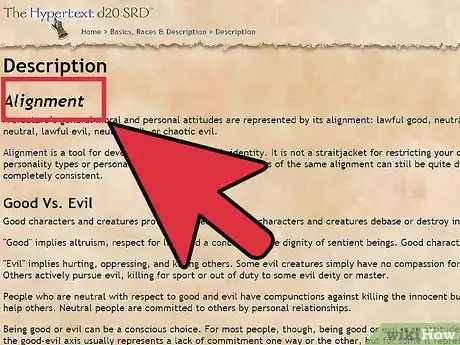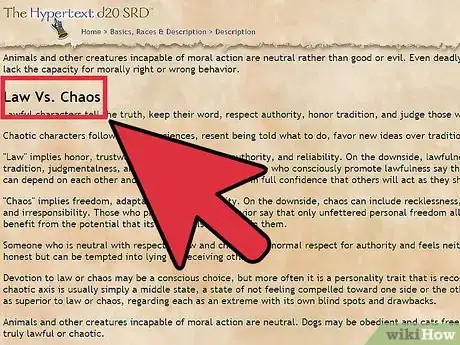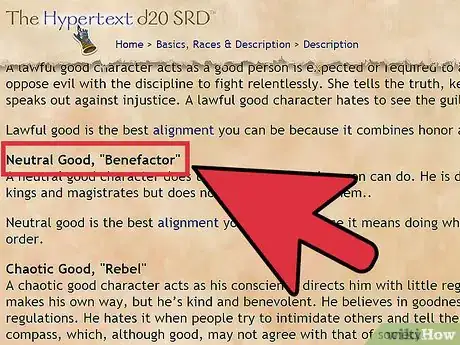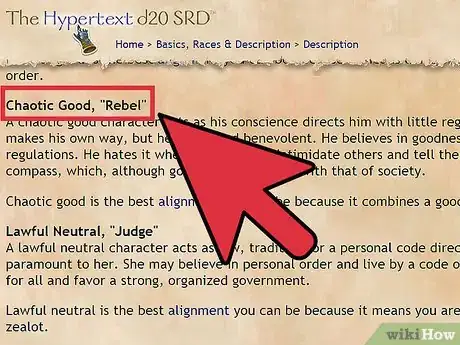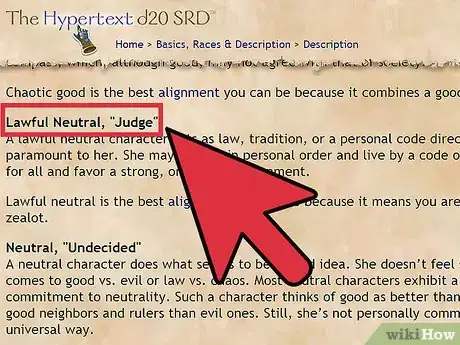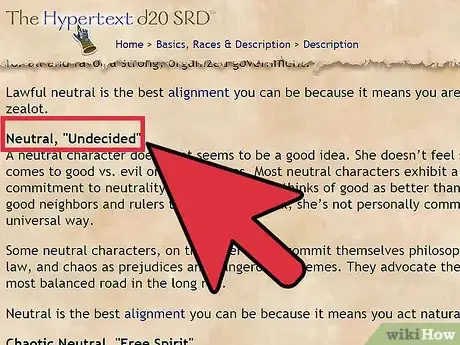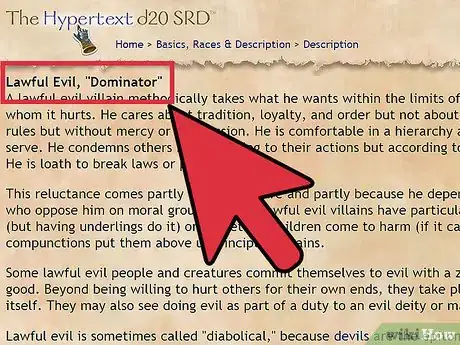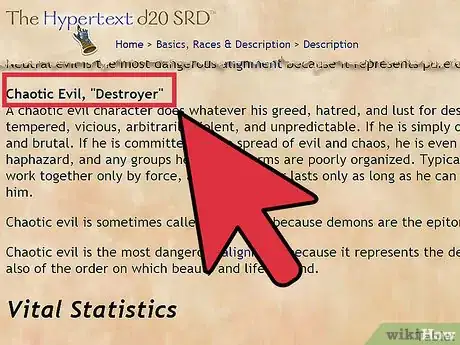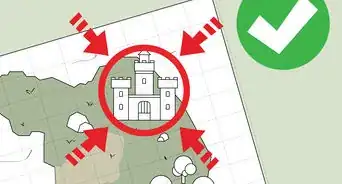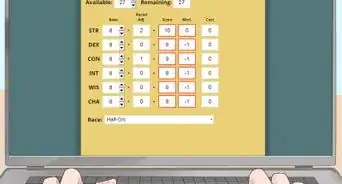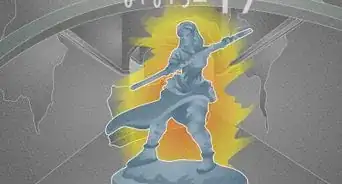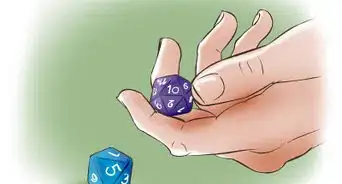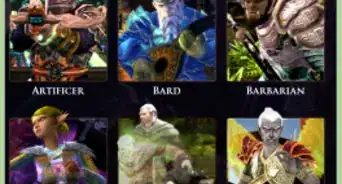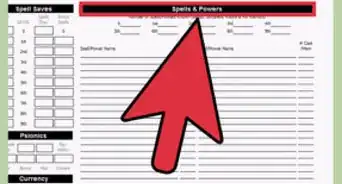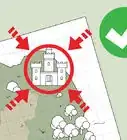X
wikiHow is a “wiki,” similar to Wikipedia, which means that many of our articles are co-written by multiple authors. To create this article, 13 people, some anonymous, worked to edit and improve it over time.
This article has been viewed 131,594 times.
Learn more...
There are nine different alignments in Dungeons and Dragons V3.5 and each one describes a completely different kind of person. This article will illustrate the differences between the alignments and help you choose which one you want. It will also help you correctly role play the alignment you have chosen.
Steps
-
1Understand that in D&D morality is an Absolute. In the real world morality is nothing but a sea of gray, however in D&D everything is very clear cut. Evil people consider themselves evil and enjoy being that way.
-
2Understand the Law/Chaos axis. Everyone gets the good/evil axis but not everyone understands the law/chaos axis. Nearly everyone understands the description "lawful" but there is a lot of confusion when it comes to "chaotic". Being of a chaotic alignment does not mean that your character is random in their actions. Try to think of chaotic as the opposite of lawful as evil is the opposite of good. Chaotic in D&D alignments means independent, free, and distrustful of authority. These characters are the type of people who resent being told what to do.Advertisement
-
3Lawful Good. Lawful good characters have a strict moral code, usually coinciding with societal mores, and they almost never break it. They favor order, structure, and upright behavior. They will desire to help others when the opportunity presents itself, unless doing so would conflict with their moral code. These characters would not break the law except in very rare circumstances. They do not feel that the ends ever justify the means. A "by the book" cop is an example of a real life lawful good person.
-
4Neutral Good. Neutral good characters always do what is good, right, or helpful which is why this alignment is sometimes called True Good. Unlike lawful good characters they are more flexible in their day to day actions. A neutral good character would consider bending the rules to do what is right. A doctor who fudges paperwork to help a needy person get health insurance is a neutral good person.
-
5Chaotic Good. These people want to do what is right but they do not do it with any real structure or system. They are perfectly willing to break the law to do what is right, and some even enjoy doing just that. The best time to play a chaotic good character is when there is a lawful evil authority to rebel against. Without such a target for a rebellion many chaotic good characters are indistinguishable from neutral good characters. A hacker who uses his skills to take down child pornography sites is chaotic good, willfully breaking the law to do good. Robin Hood is the most famous example of chaotic good.
-
6Lawful Neutral. Lawful neutral people tend to be dispassionate and calculating. They have a set of behavioral guidelines but these guidelines allow for some good and some evil behavior. A lawful neutral character tends to care a lot more about the letter of the law than the spirit. An ideal judge would be lawful neutral, making all rulings based on the letter of the law without an eye towards helping or hurting others or their personal feelings.
-
7True Neutral. Neutral characters are hard to play because they lack defining moral values. This is essentially a person who evaluates each situation independently and makes a decision, but the criteria might be different in each different situation. If you play this alignment you must balance all your decisions on both the law/chaos and good/evil axis. A true neutral person in real life is almost unheard of.
-
8Chaotic Neutral. Chaotic neutral is the ultimate free spirit. This character essentially does what they want when they want regardless of whether or not it is good or evil, legal or not. Chaotic Neutral is sometimes referred to as "evil light" because many people feel it borders on evil without technically being evil. Most antiheroes in fiction and literature are Chaotic Neutral.
-
9Lawful Evil. Lawful evil characters are in essence, tyrants or dictators. They have a code of laws that is generally oppressive and brutally enforced. Lawful evil characters do not tolerate anyone questioning their authority, nor will they share their authority. A lawful evil character is out for personal gain, but is more given to scheming and intimidation than to random bloodshed. Don Corleone is one example, although there certainly are others who are more evil.
-
10Neutral Evil. Neutral evil characters are essentially pure evil. They do not follow any set of laws, nor are they concerned with obtaining power. They tend to be the kind of people who enjoy hurting others. They are not concerned with the law in the slightest. Serial killers are often neutral evil.
-
11Chaotic Evil. Chaotic evil characters are psychopaths. They do not care for anything but themselves. They kill indiscriminately and for fun. They can only be controlled by threats and force and will probably kill anyone who controls them the moment they think they can. Chaotic evil characters are almost always solitary. The latest incarnation of the Joker would be a prime example.
Advertisement
Community Q&A
-
QuestionI want to play as a evil character, but my DM will not let me. Any thoughts?
 PreuxFoxTop AnswererIt is common for many DMs not to allow evil characters. Remember they are crafting the entire campaign for you to play; if they think an evil character won't work for the game, then they are the one who would know the best. Find another type of character you want to play.
PreuxFoxTop AnswererIt is common for many DMs not to allow evil characters. Remember they are crafting the entire campaign for you to play; if they think an evil character won't work for the game, then they are the one who would know the best. Find another type of character you want to play. -
QuestionWhat about a character who changes alignment? Maybe they suffer a trauma that alters their worldview or something. The Lawful-Good Paladin's wife dies, and he breaks the law for justice, maybe?
 PreuxFoxTop AnswererCharacters can definitely change alignment during the campaign. However, keep in mind that traditionally, if a paladin or a cleric changes to an alignment that doesn't match their god's alignment, they could lose the powers given to them by their god, in which case the DM may force you to change the character's class or even abandon them and roll a new character.
PreuxFoxTop AnswererCharacters can definitely change alignment during the campaign. However, keep in mind that traditionally, if a paladin or a cleric changes to an alignment that doesn't match their god's alignment, they could lose the powers given to them by their god, in which case the DM may force you to change the character's class or even abandon them and roll a new character.
Advertisement
Warnings
- Clerics must be no more than one step different from their patron deity. (If it helps, imagine a tic-tac-toe grid.)⧼thumbs_response⧽
- If you are playing your character differently than your alignment the DM can and may change your alignment.⧼thumbs_response⧽
- Barbarians and Bards cannot be lawful.⧼thumbs_response⧽
- Monks must be some form of lawful.⧼thumbs_response⧽
- Druids must be some form of neutral.⧼thumbs_response⧽
- Paladins must be lawful good.⧼thumbs_response⧽
Advertisement
About This Article
Advertisement
